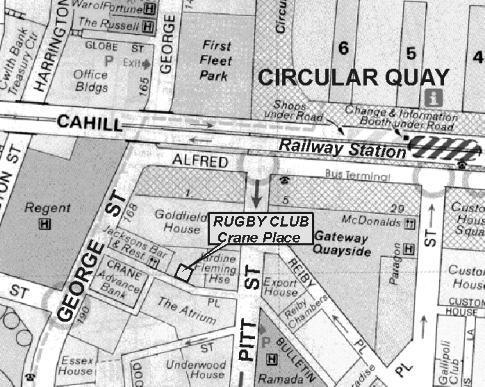
Rugby Club Location Map - Click to Enlarge
Conditions of Formation of Copeton Diamonds and their Significance
Larry Barron presenting, co-authors Jane Barron, Terry Mernagh, Garry Duncan
Rugby Club - 5:30 p.m. Thursday, 20th May 2004.
Conditions of Formation of Copeton Diamonds
LAWRENCE M. BARRON 1, B.JANE BARRON 2, TERRENCE P. MERNAGH 3
1 Geological Survey of New South Wales, PO Box 536, St Leonards New South Wales 1590, Australia,
2 BJ Barron Petrologist, 7 Fairview Avenue, St. Ives, NSW, Australia 2075,
3 Geoscience Australia, GPO Box 378, Canberra ACT 2601 Australia
Copeton and Bingara Tertiary alluvial deposits produced about 94% and 4% respectively of the two million diamonds mined in NSW, more than 1000km from the nearest craton. Laser Raman spectroscopy is used to determine the remnant internal pressure on inclusions in six Copeton diamonds: 30, 33, and 35 kbar for coesite, 13.6 and 23 kbar for diopsidic omphacite, and 8 kbar for grossular garnet. These generate six PT loci that restrict the range of diamond formation conditions from 400 ºC, 48 kbar to 880 ºC, 54 kbar (± 50 ºC and ± 4 kbar). The diamonds formed 250- 400 ºC too low to be cratonic diamond (only subduction!), argon age dates on Copeton and Bingara diamonds should be interpreted as the age of crystallization (not emplacement), the diamonds formed by Carboniferous ultra high pressure (UHP) metamorphism in Eastern Australia, and there is a local source for Copeton diamonds.
Eclogitic garnets and a conceptual model for Phanerozoic subduction diamonds, Bingara area, New England Fold Belt, NSW
B.JANE BARRON 1, L.M. BARRON 2, G. DUNCAN 3
1 Consulting Petrologist, 7 Fairview Ave., St Ives, NSW 2075, Australia.
2 Geological Survey of New South Wales, PO Box 536, St Leonards New South Wales 1590, Australia.
3 Rimfire Pacific Mining NL, Level 13, 379 Queen Street Brisbane, Queensland 4000, Australia.
Although Bingara (north eastern NSW) is located in the low metamorphic grade, accreted basement rocks of the Phanerozoic New England Fold Belt, abundant diamonds were mined here from Tertiary alluvial deposits. Samples of the nearby modern drainage system and soils, taken by Rimfire Pacific Mining NL, yielded five diamonds and high pressure (HP) to ultrahigh-pressure (UHP) metamorphic minerals such as garnet, corundum, kyanite, staurolite, rutile, and sapphirine. Using the Bingara garnet compositions and known tectonic setting we investigate the mantle, and present a conceptual model for subduction formation of diamonds and UHP garnets, and their delivery to the surface.
Most garnets are from eclogites originating from two types of MORB (mid-oceanic ridge basalt and picrite); eclogite after arc-related basalt; and orthogneiss derived from subducted continental crust. Protolith obduction is indicated by abundant crystallographically oriented (exsolved) rutile rods in some garnets, formed by changes in UHP garnet compositions in response to decompression.
We propose that buoyant continental crust (Lord Howe Rise Microcontinent) was attached to, and deeply subducted with Carboniferous oceanic slab. This facilitated significant and rapid partial obduction of eclogitic diamond- and garnet-bearing material to levels accessible for sampling by relatively shallow-sourced local magmas (such as basanite and even dolerite), without invoking deep-sourced kimberlitic or lamproitic volcanism. Stacked slabs under the Bingara region (forming a buried UHP terrane or proto- keel) allowed such magmas to access garnets and diamonds of different Phanerozoic ages and types. Abundant diatremes and pre-Tertiary igneous rocks in Eastern Australia therefore provide attractive targets for discovery of a commercial diamond deposit in an ‘unconventional’ tectonic setting.

Rugby Club Location Map - Click to Enlarge